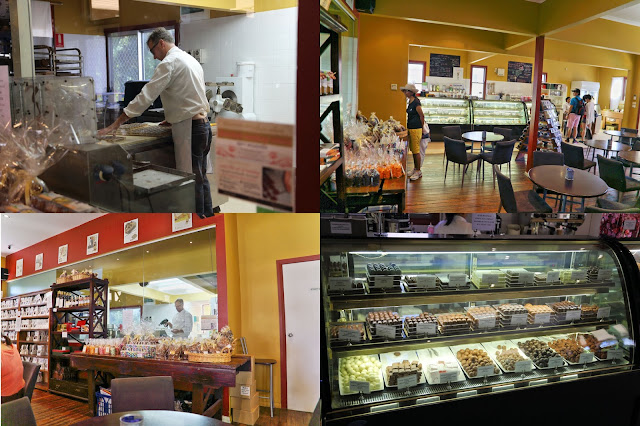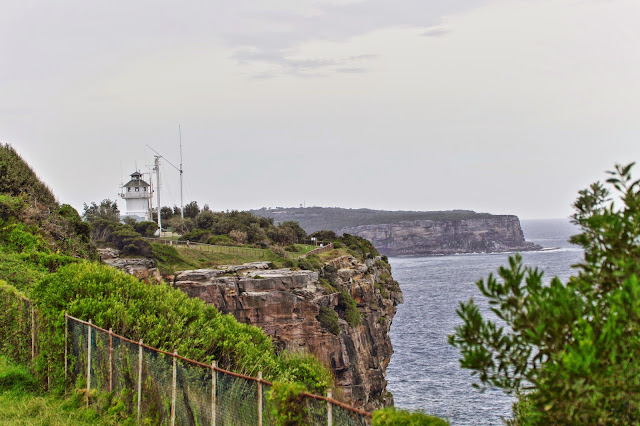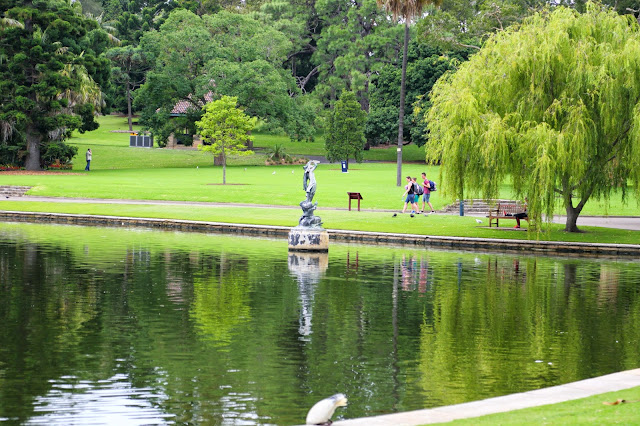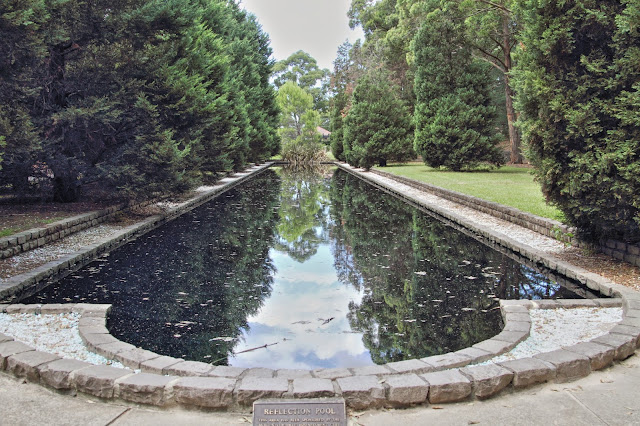The Blue Mountains is a world heritage area and gets its name from the blue haze that is developed when sunlight is refracted from the droplets of the Eucalyptus oil exuded from the trees within this forest area. It is this oil that fuels the massive and dangerous forest fires that occur in the Blue mountains Region.
We chose a bright and sunny day for our one day trip to this much talked about place. At the Blue Mountains, just outside a station called Katoomba is the visitor centre from where we collected our unlimited tickets for the the rides in the scenic world, as well as, for the services of the Hop-On Hop-Off bus and a booklet containing information about the region with a map detailing the route and the timings of the Hop-On Hop-Off bus.
This bus had drops and pick ups close to the different attraction points. Also, the bus driver gave an entertaining commentary on the Points that the bus was heading towards. We chose the Scenic World as our first stop, which had four attractions, the Skyway, the Cableway, the Railway and the Rainforest walk.
Our first ride for the day was the Skyway which is said to be the highest cable car in Australia, from the scenic world top station. There are a limited number of persons that can be accommodated on the Skyway and since Del and I were the last to get in, our ride was rather crowded.
The cable car on this journey travels for a short distance but very slowly; our ride lasted for less than five minutes, nevertheless, we did manage to catch beautiful glimpses of the Three Sisters and the Jamison Valley.
To be in a glass bottomed, glass enclosure gliding over trees, a valley and a waterfall is a feeling hard to describe!!
Once out of the Skyway, we walked towards the Jamison valley lookout but since it was very crowded, we instead chose to take a short but refreshing five minute walk along the cliff.
We returned to the Scenic World Top Station via the Skyway and geared ourselves for the Scenic Railway ride. This railway line which has been operating since 1945 has a 52 degree incline and is said to be the steepest passenger railway in the world! It descends about 310 meters while passing through a tunnel!
The seats of the train could be adjusted for an adventurous or a laid back kind of journey. During our descent, at one point, I was feeling very nervous and felt my heart pounding hard against my chest! The ride however, was very short, just lasted for a minute or two; it was a sheer thrill for many but scary to me since I am not much of an adrenaline junkie. However, it must be said that the ride may fall short on the thrill factor for those who are accustomed to adrenaline-rush themed park rides.
After our train ride, we chose to go for the 2.4km boardwalk through the rainforest. There are walks of various duration which are clearly sign posted, most of which were wheelchair accessible.
Our walk started with a brief introduction to coal mining in the area which included information on the kind of work and the life of the miners. Some of the tools that were used by these miners were on display. There were audio recordings too, simulating the sounds of the environment of the coal mines, with recordings of the sounds of both the engines used to carry coal and the mining activity. The laborious and hazardous nature of work that these miners were involved in was highlighted.
As we walked further, we were greeted by the tall trees in the valley, a few of them were sign posted.
The boardwalk was dotted with benches and a couple of gazebos where one could relax, breathing in the fresh air while at the same time biting into a quick snack.We had our lunch in a so called 'rainforest room' which had a number of benches to choose from. Eating in such quietude among trees with the occasional call of the birds was an experience we would like to replicate more often.
None of the points on this boardwalk were really spectacular, however, we did learn a lot and it still remained the highlight of our day because it is indeed very rare to walk in a forest in such comfort! Having said that, it cannot be denied that such a kind of walk would be a disappointment for seasoned trekkers who enjoy the challenges that one associates with a trek.
Our rainforest walk terminated at the bottom station of the cableway; we chose to use this ride in order to reach to the top of the escarpment. Once inside the glass enclosure which made up the cable car, it was a steep ascend to the top, the ride that lasted for not more than two minutes. We found the views from this cable car to be far more enchanting than those from the Skyway. Del was so lost in the beauty that encapsulated us, that it was one of those rare instances when he actually forgot that he had a camera in his hand!
We exited through the Scenic World top station which housed a souvenir shop, as well as, toilets and a cafe.
Our next stop was at the Chocolate factory where handmade chocolates were made and sold. It also had a cafe where Del enjoyed munching on blueberry muffins along with his evening cuppa while I watched a Chocolatier at work! This was my first, seeing a professional chocolatier busy
with the chocolate!
With a box of chocolates in our hands, we opted to walk to our next stop, the Echo Point.With the sun beating down hard, I didn't quite enjoy this point from where we could view both, the Jamison Valley and the Three Sisters (a different angle of the same attractions). I took a seat which unfortunately too was under the wrath of the scorching sun and, gobbled on my left over wrap from lunch while Del kept clicking away, trying his best to get a panoramic image of the view. Luckily, for me, the sun had his way and soon enough we were walking towards a cafe for an ice cream, double scoops for both of us!
Being our last stop for the day, we hopped onto the Hop-On Hop-Off bus, took a seat at the upper deck and enjoyed the round to Katoomba station. We were fortunate to have chosen Katoomba station as our starting point for the return journey instead of Leura cause at Leura the train seats filled up leaving a few of the passengers standing for about an hour!
Our one day at the Blue Mountains helped us to connect to this beautiful country that we had only read about. We realised Mother Nature always makes you feel at home, she isn't really concerned about the imposed regional and geographical divisions; though in Australia, we felt loved just the same!
We chose a bright and sunny day for our one day trip to this much talked about place. At the Blue Mountains, just outside a station called Katoomba is the visitor centre from where we collected our unlimited tickets for the the rides in the scenic world, as well as, for the services of the Hop-On Hop-Off bus and a booklet containing information about the region with a map detailing the route and the timings of the Hop-On Hop-Off bus.
This bus had drops and pick ups close to the different attraction points. Also, the bus driver gave an entertaining commentary on the Points that the bus was heading towards. We chose the Scenic World as our first stop, which had four attractions, the Skyway, the Cableway, the Railway and the Rainforest walk.
The Scenic Skyway
Our first ride for the day was the Skyway which is said to be the highest cable car in Australia, from the scenic world top station. There are a limited number of persons that can be accommodated on the Skyway and since Del and I were the last to get in, our ride was rather crowded.
The cable car on this journey travels for a short distance but very slowly; our ride lasted for less than five minutes, nevertheless, we did manage to catch beautiful glimpses of the Three Sisters and the Jamison Valley.
Once out of the Skyway, we walked towards the Jamison valley lookout but since it was very crowded, we instead chose to take a short but refreshing five minute walk along the cliff.
Scenic Railway
We returned to the Scenic World Top Station via the Skyway and geared ourselves for the Scenic Railway ride. This railway line which has been operating since 1945 has a 52 degree incline and is said to be the steepest passenger railway in the world! It descends about 310 meters while passing through a tunnel!
The seats of the train could be adjusted for an adventurous or a laid back kind of journey. During our descent, at one point, I was feeling very nervous and felt my heart pounding hard against my chest! The ride however, was very short, just lasted for a minute or two; it was a sheer thrill for many but scary to me since I am not much of an adrenaline junkie. However, it must be said that the ride may fall short on the thrill factor for those who are accustomed to adrenaline-rush themed park rides.
Rainforest Walk
After our train ride, we chose to go for the 2.4km boardwalk through the rainforest. There are walks of various duration which are clearly sign posted, most of which were wheelchair accessible.
Our walk started with a brief introduction to coal mining in the area which included information on the kind of work and the life of the miners. Some of the tools that were used by these miners were on display. There were audio recordings too, simulating the sounds of the environment of the coal mines, with recordings of the sounds of both the engines used to carry coal and the mining activity. The laborious and hazardous nature of work that these miners were involved in was highlighted.
As we walked further, we were greeted by the tall trees in the valley, a few of them were sign posted.
The boardwalk was dotted with benches and a couple of gazebos where one could relax, breathing in the fresh air while at the same time biting into a quick snack.We had our lunch in a so called 'rainforest room' which had a number of benches to choose from. Eating in such quietude among trees with the occasional call of the birds was an experience we would like to replicate more often.
None of the points on this boardwalk were really spectacular, however, we did learn a lot and it still remained the highlight of our day because it is indeed very rare to walk in a forest in such comfort! Having said that, it cannot be denied that such a kind of walk would be a disappointment for seasoned trekkers who enjoy the challenges that one associates with a trek.
Scenic Cableway
Our rainforest walk terminated at the bottom station of the cableway; we chose to use this ride in order to reach to the top of the escarpment. Once inside the glass enclosure which made up the cable car, it was a steep ascend to the top, the ride that lasted for not more than two minutes. We found the views from this cable car to be far more enchanting than those from the Skyway. Del was so lost in the beauty that encapsulated us, that it was one of those rare instances when he actually forgot that he had a camera in his hand!
We exited through the Scenic World top station which housed a souvenir shop, as well as, toilets and a cafe.
Other Points
Our next stop was at the Chocolate factory where handmade chocolates were made and sold. It also had a cafe where Del enjoyed munching on blueberry muffins along with his evening cuppa while I watched a Chocolatier at work! This was my first, seeing a professional chocolatier busy
with the chocolate!
With a box of chocolates in our hands, we opted to walk to our next stop, the Echo Point.With the sun beating down hard, I didn't quite enjoy this point from where we could view both, the Jamison Valley and the Three Sisters (a different angle of the same attractions). I took a seat which unfortunately too was under the wrath of the scorching sun and, gobbled on my left over wrap from lunch while Del kept clicking away, trying his best to get a panoramic image of the view. Luckily, for me, the sun had his way and soon enough we were walking towards a cafe for an ice cream, double scoops for both of us!
Being our last stop for the day, we hopped onto the Hop-On Hop-Off bus, took a seat at the upper deck and enjoyed the round to Katoomba station. We were fortunate to have chosen Katoomba station as our starting point for the return journey instead of Leura cause at Leura the train seats filled up leaving a few of the passengers standing for about an hour!
Above collage : our view from the hop-on hop-off bus,
Our one day at the Blue Mountains helped us to connect to this beautiful country that we had only read about. We realised Mother Nature always makes you feel at home, she isn't really concerned about the imposed regional and geographical divisions; though in Australia, we felt loved just the same!



















































